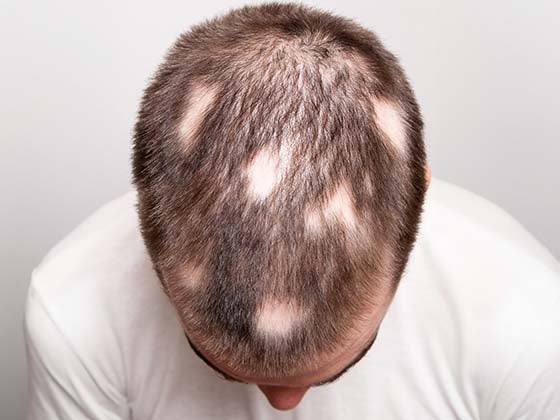Hair shedding is a common occurrence for many people, but it can also be a source of concern and insecurity. Hair shedding refers to the process of hair falling out naturally as part of the hair growth cycle. However, excessive hair shedding, beyond what is considered normal, can be a sign of a underlying health condition or a result of certain lifestyle factors. In this blog, we will explore the causes of hair shedding, tips for preventing it, natural remedies, how to tell the difference between normal shedding and excessive hair loss.
Understanding the causes of hair shedding

Hair shedding can be caused by a variety of factors, including:
-
Genetic predisposition: Some people may be genetically predisposed to hair shedding, and it may run in the family.
-
Hormonal changes: Hormonal changes, such as pregnancy, menopause, or thyroid imbalances, can also trigger hair shedding.
-
Medical conditions: Medical conditions such as autoimmune diseases, alopecia, or fungal infections can also cause hair shedding.
How to tell the difference between normal hair shedding and excessive hair loss

It's important to understand that some hair shedding is normal, and it's estimated that we lose 50 to 100 hairs a day. However, if you're losing more hair than this or if you're noticing bald spots, it's considered excessive hair loss.
The role of genetics in hair shedding

Genetics can play a significant role in hair shedding, and some people may be more prone to it due to their family history. Consulting with a genetic counsellor can help you understand your genetic predisposition to hair shedding and help you take proactive steps to prevent it.
Tips for preventing hair shedding

While hair shedding is a natural process, there are certain steps you can take to reduce it:
-
Maintain a healthy diet: A diet that is rich in vitamins and minerals, especially biotin, can help support healthy hair growth.
-
Reduce stress: Stress can have a negative impact on hair growth, so reducing stress through mindfulness, exercise, or other methods can help.
-
Avoid harsh hair treatments: Chemicals and heat can damage hair, leading to shedding, so it's best to avoid harsh treatments like bleach, perms, or straightening irons.
Dietary and Lifestyle Changes to Reduce Hair Shedding

Reducing hair shedding often involves adopting a holistic approach that includes dietary and lifestyle changes. Here are some tips to help reduce hair shedding:
-
A diet rich in vitamins, minerals, and protein is essential for healthy hair growth. Include plenty of fruits, vegetables, lean proteins, and whole grains in your meals to provide your body with the nutrients it needs for strong and healthy hair.
-
Drinking an adequate amount of water is crucial for maintaining overall health, including the health of your hair. Aim to drink at least 8 glasses of water per day to stay hydrated.
-
Chronic stress can contribute to hair shedding, so finding ways to manage stress is important. Practice relaxation techniques such as deep breathing, meditation, yoga, or spending time in nature to reduce stress levels.
-
Excessive heat styling, chemical treatments, and tight hairstyles can damage the hair shaft and lead to breakage and shedding. Limit the use of heat styling tools, opt for gentle hair care products, and avoid tight hairstyles that pull on the hair.
-
Treat your hair gently to minimize breakage and shedding. Use a wide-tooth comb to detangle wet hair, avoid brushing or combing your hair when it's wet, and pat your hair dry with a soft towel instead of rubbing it vigorously.
-
UV radiation from the sun can weaken the hair shaft and lead to breakage and shedding. Wear a hat or use a hair sunscreen to protect your hair when spending time outdoors.
-
Regular physical activity improves blood circulation, which can promote hair growth and reduce shedding. Aim for at least 30 minutes of moderate exercise most days of the week.
-
Lack of sleep can disrupt hormone levels and contribute to hair shedding. Aim for 7-9 hours of quality sleep per night to support overall health and hair growth.
-
If your diet is deficient in certain nutrients, consider taking supplements to improve hair health. Biotin, vitamin D, iron, and omega-3 fatty acids are all essential for hair growth.
By making these dietary and lifestyle changes, you can help reduce hair loss and promote stronger, healthier hair. If you have excessive or persistent hair shedding, consult a healthcare professional or dermatologist to rule out any underlying medical conditions.
Effective Hair Care Routines to Minimize Shedding

To minimize shedding and promote healthy hair growth, it's essential to establish an effective hair care routine. Here are some tips for creating a routine that can help reduce shedding:
-
Choose sulfate-free and gentle shampoo and conditioner formulated for your hair type. Avoid products with harsh chemicals that can strip the hair of its natural oils and lead to breakage and shedding.
-
Wash your hair regularly to keep your scalp clean and healthy. However, avoid washing it too frequently, as this can strip the hair of its natural oils and lead to dryness and breakage. Aim to wash your hair 2-3 times per week, or as needed based on your hair type and lifestyle.
-
Massaging your scalp while shampooing can help stimulate blood circulation and promote hair growth. Use your fingertips to gently massage your scalp in circular motions to help loosen dirt, debris, and excess oil.
-
After washing your hair, use a wide-tooth comb to detangle your hair gently. Start from the ends and work your way up to the roots to minimize breakage and shedding.
-
Limit the use of heat styling tools such as flat irons, curling irons, and blow dryers, as excessive heat can damage the hair shaft and lead to breakage and shedding. When using heat styling tools, use a heat protectant spray to minimize damage.
-
Use a silk or satin pillowcase to reduce friction and prevent breakage while sleeping. You can also protect your hair by wearing a silk or satin scarf or bonnet at night.
-
Regular trims help prevent split ends and breakage, which can lead to shedding. Aim to trim your hair every 6-8 weeks to keep it healthy and strong.
-
Wet hair is more prone to breakage, so be extra gentle when handling your hair after washing. Avoid rubbing your hair vigorously with a towel and instead pat it dry gently. Use a wide-tooth comb or your fingers to detangle wet hair, starting from the ends and working your way up to the roots.
-
A healthy diet rich in vitamins, minerals, and protein is essential for strong and healthy hair. Include plenty of fruits, vegetables, lean proteins, and whole grains in your diet to provide your hair with the nutrients it needs to thrive.
By following these tips and establishing a consistent hair care routine, you can help minimize shedding and promote healthy, strong hair growth. If you're experiencing excessive or persistent shedding, it's a good idea to consult with a healthcare professional or dermatologist to rule out any underlying medical conditions.
Natural remedies for hair shedding

In addition to lifestyle changes, there are also natural remedies that can help reduce hair shedding:
-
Supplements: Health supplements like biotin, iron, and zinc can help support hair health and reduce shedding.
-
Essential oils: Essential oils like lavender, rosemary, and peppermint can be used to massage the scalp, promoting circulation and reducing hair shedding.
-
Scalp massage: Regular scalp massage can improve circulation and promote healthy hair growth.
Herbal Treatments for Strengthening Hair
Several herbs are thought to improve hair strength and overall health. Here are a few popular ones:
-
Amla (Indian Gooseberry): Amla contains vitamin C and antioxidants, which can help strengthen hair follicles, promote hair growth, and prevent premature greying.
-
Bhringraj (Eclipta alba): Bhringraj has traditionally been used in Ayurvedic medicine to promote hair growth, reduce hair loss, and prevent baldness. It is thought to nourish the scalp and hair follicles, resulting in better overall hair health.
-
Fenugreek (Methi): Fenugreek seeds contain protein, iron, and other nutrients that can strengthen hair and prevent breakage. Fenugreek also contains lecithin, which moisturises the hair and reduces frizz.
-
Rosemary: Rosemary has antimicrobial properties that can benefit scalp health. It increases blood circulation to the scalp, which promotes hair growth and prevents hair loss.
-
Lavender: Lavender oil is good for the health of the scalp because it is calming and anti-inflammatory. It can support healthy hair growth by lowering inflammation, itching, and dandruff.
-
Ginseng: It is thought that ginseng extract stimulates hair follicles and encourages hair growth. It can also help to strengthen the hair strands and prevent breakage.
-
Hibiscus: Hibiscus flowers and leaves are rich in vitamins and amino acids that nourish the hair and promote hair growth. Hibiscus also has astringent properties that help balance the scalp's pH and prevent dandruff.
-
Saw palmetto: Saw palmetto extract is a popular treatment for hair loss, especially in males who have baldness with a masculine pattern. It is thought to prevent the hormone dihydrotestosterone (DHT), which is linked to hair loss, from being produced.
These herbs can be used in a variety of ways, including as teas, oils, extracts, and components of rinses and masks for hair. While herbal treatments can be beneficial to hair health, it is critical to conduct a patch test before using any new product to ensure that you do not experience an allergic reaction. Furthermore, if you have any underlying health conditions, are pregnant, or are breastfeeding, you should consult with a healthcare professional before trying herbal remedies.
Home-Made Hair Masks for Shedding Control

Homemade hair masks can be an excellent way to control shedding and promote overall hair health. Here are a few DIY hair mask recipes that you can try:
-
Egg and Olive Oil Mask: 1 egg, 2 tablespoons of olive oil. Beat the egg and mix it with olive oil until well combined. Apply the mixture to your scalp and hair, focusing on the roots and tips. Leave it on for 30 minutes to an hour, then rinse thoroughly with lukewarm water and shampoo.
-
Avocado and Banana Mask: 1 ripe avocado, 1 ripe banana. Mash the avocado and banana together until smooth. Apply the mixture to your hair, concentrating on the ends. Cover your hair with a shower cap and leave the mask on for 30 minutes to an hour. Rinse thoroughly with lukewarm water and shampoo.
-
Yogurt and Honey Mask: 1/2 cup of plain yogurt, 2 tablespoons of honey. Mix the yogurt and honey until well combined. Apply the mixture to your scalp and hair, massaging it in gently. Leave the mask on for 30 minutes, then rinse thoroughly with lukewarm water and shampoo.
-
Coconut Oil and Aloe Vera Mask: Combine 2 tablespoons coconut oil with 2 tablespoons aloe vera gel. Mix the coconut oil and aloe vera gel until well combined. Apply the mixture to your scalp and hair, concentrating on the roots and ends. Leave it on for 30 to 60 minutes, then thoroughly rinse with lukewarm water and shampoo.
-
Apple Cider Vinegar Rinse: Combine 1 part vinegar and 2 parts water. Mix the apple cider vinegar with the water. After shampooing your hair, apply the mixture to your scalp and hair, massaging it in thoroughly. Leave it on for a few minutes before thoroughly rinsing it with water.
These homemade hair masks can nourish and strengthen your hair while reducing shedding and encouraging healthy growth. You can use them once or twice a week for the best results. If you have any allergies or sensitivities to certain ingredients, conduct a patch test before applying the mask to your hair and scalp.
The importance of seeking professional help

If you're experiencing excessive hair shedding, it's important to consult a dermatologist or trichologist. These professionals can help you identify the underlying cause of your hair shedding and develop a customised treatment plan. This may involve medications, lifestyle changes, or other treatments to help reduce hair shedding and promote hair growth.
In conclusion, hair shedding is a natural process that occurs as part of the hair growth cycle, but excessive hair shedding can be a sign of an underlying health condition or the result of certain lifestyle factors. By understanding the causes, taking preventive steps, and seeking professional help, it's possible to reduce hair shedding and promote healthy hair growth.
The impact of hair shedding on self-esteem and confidence

Hair shedding can have a significant impact on self-esteem and confidence, and it can be a source of distress for many people. Coping with hair shedding may involve developing a healthy self-image, seeking support from loved ones, or seeking professional help from a dermatologist or trichologist.
The latest treatments and techniques for addressing hair shedding

There are a variety of treatments and techniques available for addressing hair shedding, including:
-
Hair transplants: Hair transplants involve removing hair from one area of the scalp and transplanting it to another area that is thinning or balding.
-
Scalp micropigmentation: Scalp micropigmentation is a cosmetic procedure that involves tattooing the scalp to give the appearance of fuller, thicker hair.
-
Medications: Certain medications, such as minoxidil or finasteride, can help reduce hair shedding and promote hair growth.
Stress and Its Effects on Hair Health

Stress can indeed have a significant impact on hair health. Here's how it is done:
-
Telogen Effluvium: Stress can trigger telogen effluvium, a disorder that causes a large number of hair follicles to enter a resting phase. This may cause significant hair loss, resulting in a brief thinning of the hair.
-
Alopecia Areata: Stress is thought to be a trigger for autoimmune conditions such as alopecia areata, in which the immune system misidentifies hair follicles and causes patchy hair loss.
-
Hair Cycle Disruption: Chronic stress can disrupt the normal hair growth cycle, causing irregular growth patterns and even hair loss.
-
Trichotillomania: In severe cases of stress, some people develop trichotillomania, which is characterised by a compulsive urge to pull out their hair, resulting in noticeable hair loss.
-
Premature Greying: Although not directly related to hair loss, stress has been linked to premature greying of hair. High levels of stress can hasten the greying process by depleting melanin-producing cells in the hair shafts.
-
Scalp Health: Stress can have an impact on the overall health of the scalp, potentially causing dandruff, itchiness, and other scalp conditions that can have an indirect impact on hair quality.
Stress can be lessened by managing it using a variety of methods, including exercise, meditation, counselling, and leading a healthy lifestyle. The general health of your hair can also be supported during stressful times by eating a balanced diet full of vitamins and minerals that are vital for healthy hair growth.
Vitamins and Supplements for Hair Growth

Several vitamins and supplements can help promote hair growth and overall hair health:
-
Biotin (Vitamin B7): Biotin is probably the most well-known supplement for hair growth. It promotes the production of keratin, the protein that makes up hair, skin, and nails.
-
Vitamin A: Vitamin A helps to produce sebum, which moisturises the scalp and keeps hair healthy.
-
Vitamin C: As an antioxidant, vitamin C protects hair follicles from free radical damage. It also promotes the production of collagen, which is required for hair growth.
-
Vitamin D: Vitamin D deficiency has been linked to hair loss, so ensuring adequate levels of vitamin D may support healthy hair growth.
-
Vitamin E: Vitamin E is another antioxidant that can help reduce oxidative stress on the scalp and promote healthy hair growth.
-
Iron: A common cause of hair loss, particularly in women, is iron deficiency anaemia. Iron supplements can help raise iron levels and enhance the condition of hair.
-
Zinc: Zinc has been connected to hair loss and is important for the growth and repair of hair tissue.
-
Omega-3 Fatty Acids: Flaxseed and fish oils contain omega-3 fatty acids, which can support scalp health and reduce inflammation, both of which may encourage hair growth.
-
Protein: Since protein makes up the majority of hair, eating a sufficient amount of it is necessary for healthy hair growth.
Though these vitamins and supplements can help maintain healthy hair, it is important to remember that they cannot replace a well-balanced diet. Before beginning any new supplement regimen, it is also advisable to speak with a healthcare provider, particularly if you have any underlying medical conditions or are currently taking medication.
Hormonal Imbalances and Hair Loss

Hormonal imbalances can indeed cause hair loss in both men and women. Here are some important hormonal factors that can influence hair health:
-
Androgens: This group of hormones includes testosterone. In both men and women, an excess of androgens can cause hair loss. This can cause male-pattern baldness in men, and female-pattern hair loss in women.
-
Estrogens: Estrogens, particularly in women, play a role in maintaining hair growth. Fluctuations in oestrogen levels, such as those that occur during pregnancy, menopause, or when using hormonal contraception, can cause temporary hair loss.
-
Thyroid Hormones: Thyroid hormones regulate metabolism and can affect hair growth. Both hypothyroidism (underactive thyroid) and hyperthyroidism (overactive thyroid) can cause hair thinning and loss.
-
Cortisol: Cortisol, also known as the stress hormone, can affect hair health. Chronic stress can cause high cortisol levels, which may contribute to hair thinning and shedding.
-
Insulin and Insulin-like Growth Factor 1 (IGF-1): Insulin and IGF-1 are involved in cell growth and metabolism. Insulin resistance, which can lead to elevated insulin and IGF-1 levels, has been associated with hair loss conditions like male-pattern baldness and polycystic ovary syndrome (PCOS) in women.
-
Progesterone: Progesterone levels can also impact hair health, particularly in women. Fluctuations in progesterone levels during the menstrual cycle or hormonal changes related to pregnancy and menopause can affect hair growth.
Hormonal imbalances are frequently addressed through medical intervention, which may include hormone replacement therapy, thyroid function medication, or lifestyle changes to manage stress and improve overall hormonal balance. Consulting with a healthcare professional, such as an endocrinologist or dermatologist, can aid in the diagnosis of any underlying hormonal issues and the development of a personalised treatment plan to address hair loss.
Seasonal Variations in Hair Shedding

People commonly notice variations in hair shedding throughout the year, which is known as seasonal shedding. Here's why this happens:
-
Seasonal changes, particularly in the autumn and spring, can cause a type of hair shedding known as telogen effluvium. This happens when a large number of hair follicles enter the hair growth cycle's resting phase (telogen phase) at the same time, resulting in increased hair shedding about two to three months later. Seasonal variations, such as temperature fluctuations or changes in daylight hours, can disrupt the hair growth cycle and contribute to telogen effluvium.
-
During the summer months, increased exposure to sunlight and UV radiation can weaken the hair shaft, making it more prone to breakage and shedding. Additionally, exposure to chlorine from swimming pools or saltwater from the ocean can further contribute to hair damage and shedding.
-
In colder months, indoor heating and low humidity levels can lead to dry scalp and hair, which may increase the risk of breakage and shedding.
-
Seasonal fluctuations in hormone levels, such as those caused by the menstrual cycle or seasonal changes in melatonin production, can also have an impact on hair growth and shedding patterns.
-
Changes in diet and nutrient intake throughout the year can have an impact on hair health and shedding. For example, a lack of essential nutrients during certain seasons can contribute to hair loss or shedding.
While seasonal shedding is natural and usually temporary, it is important to distinguish it from chronic or excessive hair loss, which can indicate an underlying health problem. If you are concerned about changes in your hair shedding patterns, or if you are experiencing significant hair loss that lasts more than a few months, see a healthcare professional or dermatologist for an evaluation and appropriate treatment.









































